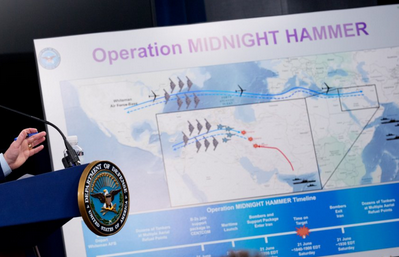Introduction
Operation Midnight Hammer has emerged as a significant topic in global news, capturing attention due to its implications for international security and Middle Eastern geopolitics. Launched in June 2025, this U.S.-led military operation targeted Iranian nuclear facilities, marking a direct escalation in U.S.-Iran relations. This article explores the operation’s objectives, execution, and the ongoing discussions surrounding it, providing a clear and concise overview for readers.
What Was Operation Midnight Hammer?
Operation Midnight Hammer was a U.S. military operation aimed at crippling Iran’s nuclear capabilities. The strikes targeted three key nuclear facilities, including sites at Isfahan, Fordo, and Natanz, which are central to Iran’s uranium enrichment program. The operation involved advanced weaponry, including B-2 Spirit stealth bombers, Tomahawk missiles, and GBU-57 Massive Ordnance Penetrators (bunker-buster bombs). According to Pentagon officials, the mission was executed with over 125 aircraft and 75 precision-guided munitions, resulting in severe damage to the targeted sites.
The operation was described as a “surgical strike” intended to neutralize Iran’s nuclear ambitions without triggering a broader conflict. U.S. officials, including General Dan Caine, Chairman of the Joint Chiefs of Staff, hailed it as a success, emphasizing the precision and effectiveness of the mission.
Context and Objectives
The strikes come amid heightened tensions over Iran’s nuclear program, particularly following the breakdown of the Joint Comprehensive Plan of Action (JCPOA) in 2018. Reports in 2024 and 2025 indicated that Iran’s enriched uranium stockpile was approaching levels suitable for weapons, prompting concerns from the U.S., Israel, and the International Atomic Energy Agency (IAEA). Operation Midnight Hammer was reportedly a preemptive measure to prevent Iran from developing nuclear weapons, aligning with U.S. and Israeli security priorities.
The operation also reflects a shift in U.S. policy under President Donald Trump’s second term, which began in January 2025. Unlike earlier diplomatic efforts to revive the JCPOA-like framework, the U.S. administration has adopted a hardline approach, prioritizing military action to address Iran’s nuclear threat.
Execution and Tactics
Operation Midnight Hammer was notable for its complexity, and use of deception. The Pentagon utilized seven B-2 bombers, supported by fourth and fifth-generation fighter jets, to deliver 14 GBU-57 bunker-buster bombs and other precision-guided weapons. Tomahawk missiles were also deployed to strike hardened targets, particularly at Isfahan. The operation was planned and executed to minimize collateral damage, with no reported civilian casualties.
General Dan Caine emphasized the operation’s high-risk nature, noting that it required flawless coordination across multiple military domains. The use of stealth technology and deceptive tactics ensured that U.S. forces faced no significant resistance, with Caine stating he was “unaware of any shots fired at the U.S. strike package.”
Reactions and Controversies
U.S. Perspective
U.S. Defense Secretary Pete Hegseth and General Caine described Operation Midnight Hammer as an “incredible success,” claiming it “obliterated” Iran’s nuclear ambitions. Supporters on platforms like X echoed this sentiment, praising the operation’s precision and its role in countering Iran’s nuclear threat.
However, critics, including Senator Bernie Sanders, condemned the strikes as “grossly unconstitutional,” arguing that President Trump bypassed Congress to authorize the operation. This has sparked debates about the legality and oversight of U.S. military actions.
Iran’s Response
Iran strongly condemned the strikes, labeling them as an act of aggression that violates international law. Iranian officials have vowed to rebuild their nuclear facilities and expand their program, raising fears of further escalation. The strikes have also intensified Iran’s rhetoric against the U.S. and Israel, complicating regional dynamics.
International and Public Sentiment
On X, discussions about Operation Midnight Hammer reflect polarized views. Some users view the strikes as a necessary step to curb Iran’s nuclear program, while others question their effectiveness, suggesting that the operation may have targeted “empty bunkers” or failed to fully dismantle Iran’s capabilities. Skeptics argue that the strikes could provoke Iran to accelerate its nuclear efforts, potentially destabilizing the region.
Internationally, allies like Israel have supported the operation, citing Iran’s nuclear program as a shared threat. However, other nations, including some European allies, have expressed concern over the unilateral nature of the strikes and their potential to undermine diplomatic efforts.
Implications for the Future
Operation Midnight Hammer has significantly altered the trajectory of U.S.-Iran relations and the broader Middle East. While the Pentagon claims the strikes set back Iran’s nuclear program, the long-term impact remains uncertain. Key questions include whether Iran will retaliate, how the international community will respond, and whether diplomatic avenues can be revived.
The operation has also reignited debates about U.S. military intervention and the balance between preemptive action and diplomacy. As battle damage assessments continue, the global community awaits further clarity on the extent of the damage to Iran’s nuclear infrastructure and the next steps in this volatile geopolitical landscape.
Conclusion
Operation Midnight Hammer represents a bold and controversial U.S. military action aimed at neutralizing Iran’s nuclear capabilities. Executed with advanced technology and strategic deception, the operation has been hailed as a tactical success by U.S. officials but faces criticism for its legal and strategic implications. As discussions unfold on platforms like X and in global forums, the operation underscores the complex interplay of security, diplomacy, and power in the Middle East. The world now watches closely for Iran’s response and the broader consequences of this high-stakes mission.
Note: This article is written for informational purposes and is free of copyrighted material. It can be used or adapted for website publication without restriction.

Leave a Reply